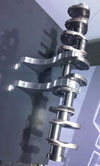Heat-treatment of crankshafts
 In the previous article, we looked at the first stages of heat-treatment in the manufacture of crankshafts. Certainly in Formula One, the most popular heat treatment that will be mentioned will be nitriding. Nitriding, as most of you will know, is a surface treatment which, if specified correctly, should have no effect on the bulk of the material, often referred to as the core.
In the previous article, we looked at the first stages of heat-treatment in the manufacture of crankshafts. Certainly in Formula One, the most popular heat treatment that will be mentioned will be nitriding. Nitriding, as most of you will know, is a surface treatment which, if specified correctly, should have no effect on the bulk of the material, often referred to as the core.
When we specify the material for the crankshaft, we need to be careful not only to specify the composition of the material, but also the level of mechanical properties that we can expect. In general, we do this by ordering the material with a given property or combination of properties within a range that we are happy with. We may deem that we want a certain level of ultimate tensile strength (UTS), or yield strength, or elongation etc. Particularly with reference to UTS, there is a very well understood relationship between this mechanical property and hardness. This allows us to specify a level of hardness for the material which has the advantage that the test can be carried out with (relatively) inexpensive equipment on any reasonably clean flat or round surface.
The method by which we achieve this desired level of hardness or strength is by the processes of hardening and tempering. Again, many of us here will understand this process in detail and specify this kind of treatment as a part of our everyday job. However, we will cover the basics of the process here without going into the ‘nitty-gritty’. There are lots of excellent textbooks on the subject, and we can cover it in later articles if there is any feedback or comments asking for this.
The hardening process involves getting the steel very hot indeed – each grade of steel will have a given temperature above which the entire structure is known as ‘austenite’. This is generally above 900 degrees C (>1650 degrees F) and depends on the grade of steel and the properties desired. In general, for most steels, austenite is not an equilibrium phase, and over time (in some cases a very long time) will change into something else. Austenite is a relatively soft phase and not many steels used in engine components use these types of steel (although poppet valves are a notable exception). However, in the controlled process of hardening, we ensure that this change happens by quenching the steel. Where the grade of steel requires that the temperature change is very rapid, the steel may be submerged in water, oil or a polymer quenchant. However, for some steels which are quite highly alloyed, the quenching can be done in air, which leads to less distortion. Generally, what is produced (or desired at least) is a phase called martensite.
Martensite is an equilibrium phase, but is extremely hard and brittle and requires a further process to make the steel usable as a crankshaft. This process is called tempering, and involves getting the steel moderately hot in the case of a crankshaft (somewhere between 500 and 700 degrees C (approximately 930 – 1300 degrees F) for a nitriding steel depending on the exact grade and the level of strength desired). Steels for other applications will temper at higher or much lower temperatures (for example, common gear steels are tempered at around 150 degrees C). As for stabilisation (stress-relief), tempering depends on a combination of time and temperature. If the temperature in service (or during the rest of the manufacturing process) exceeds the tempering temperature, there is a danger of loss of mechanical properties.
Nitride hardening can affect the manufacture of crankshafts in this way. Lower tempering temperatures, in general, leads to higher hardness and strength and lower ductility. If one was to specify a high hardness, requiring a low tempering temperature, it may be that the core material would be softened by the nitriding treatment. This effect can be mitigated by careful choice of alloy if high core strength is felt to be a requirement.
However, it is quite common for crankshaft blanks to be ordered pre-hardened and tempered to the desired core hardness – careful manufacturing minimises the amount of stress-relief required, and proper specification of the nitriding process poses no danger of diminishing the required properties.
Next month we will look at what options we have for nitriding, how these processes are done and what the results are.
Written by Wayne Ward.